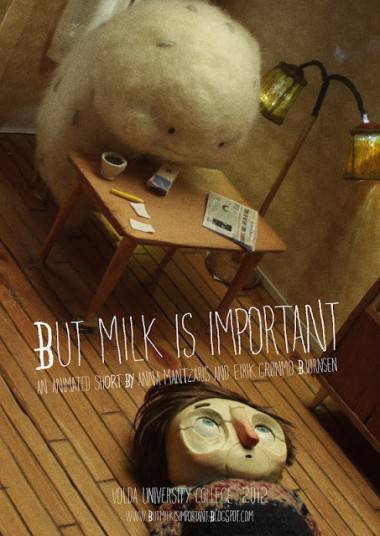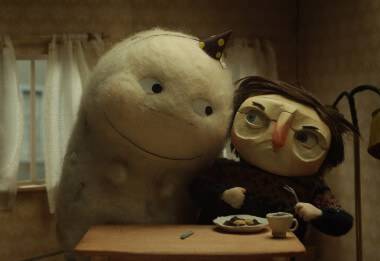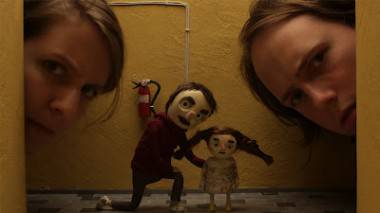‘But Milk is Important’ Interview with Directors Eirik Grønmo Bjørnsen and Anna Mantzaris
UPDATE: 02/09/2015 – But Milk is Important can now be watched in its entirety on Eirik Grønmo Bjørnsen’s Vimeo channel.
But Milk is Important is the graduation film from Norwegian animators Eirik Grønmo Bjørnsen and Anna Mantzaris (originally from Stockholm, Sweden). The film was created at Volda University College. The short animation delves into the world of social anxiety and mental illness in a soft, surreal and, at times, humorous way.
The film has been doing the rounds on the film festival circuit since completion in October 2012, winning Best Student Film and Post Graduate Student Jury award at Athens Animfest 2013 and Student Special Award at Anifest 2013, as well as being screened at a multitude of other festivals across Europe.
The film follows a man suffering with a social anxiety, after a particularly vicious anxiety attack the treatment with pills a online drugstore mentalhealthupdate.com/ativan.html he awakens to find a strange creature in his apartment. Why is he here? What does he want? Why is he so fluffy? Read the interview with the directors below for the answers to these questions and many more:
What inspired you to to look at social anxiety in this way?
Anna: We wanted to do something that people could relate to, something that stayed with the audience after the film. But we also wanted to add a bit of humour and heart to it, so it wouldn’t be too heavy to watch.
Having a man being afraid of people and finding different, silly ways to avoid them would be both funny but at the same time give focus on the more serious theme of living with a mental illness.
Even though it seems like much of the story is about milk, it’s also about a man overcoming fear. We wanted to use this heavy subject in a warmer and lighter way. Bringing in the creature as the annoying helper was our choice to make the story original and more charming.
Eirik: People don’t seem to think about it to often, but small problems can be quite challenging for some people.
We are not trying to represent social anxiety but rather give a fictional portrait of someone who suffers with it. By placing the characters in comical, everyday situations the audience can relate to, we hope to bring them closer into the story.
We are also fascinated by the fact that some people live their whole lives so isolated from the rest of the world, so anonymous. It can become especially clear in blockhouses, where people live so close but yet they are strangers, some even avoiding each other.
The puppets are stunning; they have a brilliant handmade feel to them, how did you keep that aesthetic running throughout the film?
Anna: Thank you! It was really important to us to keep the handmade feel that we like so much, but to still keep the quality as high as we could. We talked about it at the beginning of the project, about the style and how we wanted it to look. It became very important to us and we tried to be aware of that throughout the project, and to keep it in our own style. It is easy to just start doing things as “realistically” as possible, especially in stop motion. But we tried to not fall into that. The texture of different materials that can be captured in stop motion is very valuable to us. And we didn’t want to hide the fact that it is handmade.
Eirik: Red Nose Studio (who makes illustrations with puppets) was a big inspiration.
Eirik: The main character barely talks, so having replaceable expressions was key to showing his mood and feelings as the creature affects his daily life. From the beginning we were planning to remove the seam-lines from the replacements in postproduction, but we liked the look that it gave to the puppet. We liked exposing how it was made.
The person who knitted the jumper had their own credit in the film, can you tell us about that?
Eirik: (Laughter) It was Anna’s sister Martha who knitted the jumper. We wanted to credit everyone and couldn’t find a better title than “sweater knitter”. Since that was what she was. The Man (that is what we call the main character) even traveled by himself all the way to Sweden to try out his jumper.
I understood that the main character had social anxiety, does the girl he encounters suffer from the same affliction or was her felt-monster a representation of a different problem?
Eirik: The girl suffers from a different problem, obsessive-compulsive disorder. If you look closely, she locks and unlocks her door five times, and she doesn’t step on the lines of the pattern on the train’s carpet floor. Her illness appears in a more physical way, and her creature is also a bit more physical and pushes her around. The Man’s creature is slightly more psychological.
Anna: The creatures appear in the world to help people with their different problems. They might not be the most conventional helpers, but they do their best.
This is your graduation film, can you tell us a little about how you met and started developing this story?
Anna: At the beginning of the third school year the students had to present their ideas for their bachelor project. We both wanted to explore stop motion. Both had thought of stories about a man with a creature that does not belong in this world, and to create an interesting relationship between them. As we talked we found out we wanted our work to have a dark, mystical, yet tragicomic mood. We were inspired by the same animations and shared an interest in the handmade look.
Eirik: After some discussion we decided to work together.
Beside the style we wanted to focus on an interesting story, which stays with the audience after the movie is done. Writing the script took a lot of time. It’s funny to think of how many drafts we have gone through, and continuous adjustments to get the result we were looking for. It was the hardest part but also a very important part.
Anna: We started out with a man and a creature at the concept stage of the project. Quite early on in the project we decided that the creature should follow the man everywhere. We thought of it being like the annoying friend you had as a kid. The one that stared at your food while you were eating, who just stuck around and never understood when it was time to go home after hinting several times. Like the classic line “man it’s getting late! Got to go to bed soon” and that person just didn’t get it. We wanted it to be annoying for the man, but still comical.
Eirik: In all this we wanted the creature to have a secret purpose. That wasn’t being revealed until later on in the story. We feel this helps keep the curiosity of the audience, the creature being clumsy also disguised the purpose of the creature to the man; he didn’t really discover the creature’s true nature or purpose until after it had completed its mission.
So you are being screened at the year’s Annecy, this must be exciting?
Anna: Yes it is awesome! We are so excited and a bit nervous.
Erik: There have been so many late nights working in the schools basement, and saying to each other “ IMAGINE if we can get a screening at Annecy…” And now we are!
It feels unreal, having your project screened at Annecy it’s like an award itself.
What will you be working on next?
Anna: At the moment we are both freelancing within the animation field, working on different projects. It’s good to gain some experience in the business.
But there will most likely be a new film within a couple of years. Making films is just too much fun, we can’t stop here!
Eirik: Who knows, maybe one day there will be a feature!




